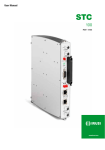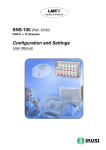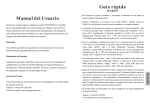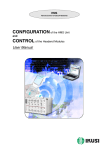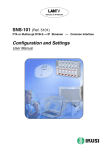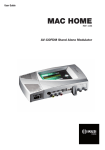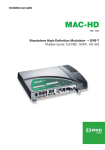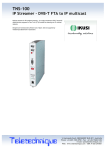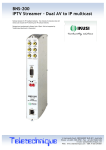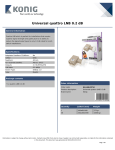Download Quick installation and configuration guide
Transcript
Quick installation and configuration guide STC 200 REF. 4466 Contents 4Introduction 4 General description 5 General use of the headend 6 Initial installation and configuration 6 Assembly, connection of signals and power supply 7 IKUNET bus configuration 11 Practical configuration examples 11 Direct connection with universal LNB parabolic antenna 17 Connection with multiswitch Introduction JJ The quick installation and configuration guide is a practical reference. To ensure the correct use and installation of the headend, it is necessary to read the user manual and troubleshooting procedure corresponding to the complete solution and to each of the individual modules. JJ IKUSI reserves the right to modify the contents of this guide without prior warning. General description 1 2 3 4 5 6 7 STC-200 9 15 10 16 11 12 13 8 14 KEY 7 RJ-45 ports for IKUNET bus A STC-200 module 8 Coupling loop DVB-T output B CFP-700 module 9 Output +12 V (5 A) C CFP-507 module 10 Output +24 V (60 mA) 1 Input 1 DVB-S/S2 channel 11 Output +18 V/22 kHz (300 mA) 2 Input 2 DVB-S/S2 channel or loop output 12 Output +13 V/22 kHz (300 mA) 3 LNB remote power supply 13 Output +18 V/0 kHz (300 mA) 4 Slot for CAM 14 Output +13 V/0 kHz (300 mA) 5 DB-9 port 15 Output +12 V (7 A) 6 DC power supply 16 Output +24 V (60 mA) The headend described in this manual is made up of the following modules: JJ 4 STC-200 (Ref. 4466): DVB-S/S2 to DVB-T transmodulator (QPSK/8PSK to COFDM). Introduction/General use of the headend JJ CFP-507 (Ref. 4439): power supply +12 V/+24 V. JJ CFP-700 (Ref. 4401): power supply +12 V/+24 V for selection of polarisation. JJ BAS-900 (Ref. 4411): base-support with capacity for 9 modules (dimensions: 563x257x24 mm). JJ MS-0504 (Ref. 1023): stand-alone multiswitch (4 SAT inputs and 4 outputs). EN NOTE Please read the detailed information in the manuals for the modules included in their respective packaging. General use of the headend This headend is designed for the emission of DVB-T (COFDM) signals from the input of free or encrypted DVB-S/S2 signals (QPSK/8PSK to COFDM). NOTE The DVB-T (COFDM) output signal requires a trunk amplifier for the correct distribution in installations for a large number of sockets. 5 Initial installation and configuration NOTE A PC with an Ethernet network card and a CAT-5E Ethernet crossover cable are required for communication with the headend. NOTE To display the graphics provided in the headend configuration program correctly, we recommend installing the Mozilla Firefox web browser (www.mozilla.com) in the control PC. Assembly, connection of signals and power supply 3 1 2 4 5 6 KEY 1 DVB-S/S2 signal input 4 Power supply bridges 2 DVB-T signal output 5 IKUNET 3 Bridging line in loop mode 6 CAM + SmartCard + protection with safety screws 1) Attach the modules to the base one by one following the instructions given in the manuals for each module. NOTE IKUSI recommends the modules are assembled in the order shown in the above figure; 6 JJ Right: CFP-700/CFP-507 power supplies. JJ Left: STC-200 transmodulators. Initial installation and configuration/IKUNET bus configuration JJ Last STC-200 on the right: Master STC-200 with the DVB-T output signal. EN 2) Connect the input and output signal connections in accordance with the instructions for the module manuals and the diagram shown in the previous figure. 3) Distribute the headend power supply as symmetrically as possible (see example in above figure). IKUNET bus configuration The IKUNET bus is an Ethernet communication bus between the headend modules. The IKUNET bus is installed using Ethernet pigtails supplied with the modules. If n is the number of station modules, n-1 Ethernet pigtails are required. Definition of the master module NOTE JJ Remember the PC configuration prior to the connection with the IKUNET bus. JJ The definition of the master module must be made with an STC-200 module. NOTE In mixed STC and MTC configurations, an STC module may never be an MTC module master. In these cases, the master module must be an MTC module and the STC modules are reserved for configuration as slave modules. 1) Start the configuration of the IKUNET bus for the headend with the modules disconnected from each other. 2) Connect the selected module ( A ) to the PC ( B ) via its Ethernet connection and using an RJ-45 cable ( C ). STC-200 STC-200 3) In the PC (Windows XP) go to START > CONTROL PANEL > NETWORK CONNECTIONS > LOCAL AREA CONNECTION > PROPERTIES > INTERNET PROTOCOL (TCP/IP) > PROPERTIES. 4) Select the USE THE FOLLOWING IP ADDRESS checkbox. Enter the following IP configuration parameters: FF IP ADDRESS: 10.254.254.2 FF SUBNET MASK: 255.255.255.0 FF DEFAULT GATEWAY: 10.254.254.1 5) Click on the ACCEPT button. 7 Initial installation and configuration/IKUNET bus configuration 6) Enter the IP address http://10.254.254.254 in the web browser. This takes you to the home page of the connected module. 7) In the home page of the selected module, “Admin” appears by default in the USER field. Enter the word “admin” in the PASSWORD field and click on ACCEPT. 8) The main management window for the STC-200 module as slave module is displayed. NOTE The module with which you have connected the PC disconnects automatically after 15 minutes without interaction. 9) In the main menu, click on MASTER MODULE > CONFIGURATION. The window GENERAL HEADEND PARAMETERS CONFIGURATION is displayed, with the INSTALATION DATA tab. 10) Enter the name of the module in the MODULE NAME field. NOTE IKUSI recommends you give a description to the module according to its position in the headend in order to identify the modules logically and physically. For example, for a configuration identical to that proposed in the assembly section, include the following identifications (on the base, from right to left: STC-1 MASTER and STC-2). 11) To activate the module as master of the headend, click on the THIS STC-200 IS THE MASTER MODULE checkbox. The module will be configured as master once the window has been saved. CAUTION If the background of the field is red, this means that the data has been modified but has not yet been saved. Before changing the window or tab, the modified data must be saved (click on SAVE). Otherwise the modified data will be lost and the headend will remain in the same state as before. NOTE If the IKUNET bus is connected to another Ethernet bus, we recommend you limit the IP range to the number of slave modules in the IKUNET bus, so that these can be identified more easily. 12) Click on EXIT in the main screen (top right corner). 8 Initial installation and configuration/IKUNET bus configuration Name of slave modules EN Continue with the IKUNET bus without connecting. Follow the steps below for each of the remaining modules of the headend (slave modules). 1) Connect the selected module ( A ) to the PC ( B ) via its Ethernet connection and using an RJ-45 cable ( C ). 2) Enter the IP address http://10.254.254.254 in the web browser. This takes you to the home page of the connected module. STC-200 STC-200 3) In the home page of the selected module, “Admin” appears by default in the USER field. Enter the word “admin” in the PASSWORD field and click on ACCEPT. 4) Enter the name of the module in the MODULE NAME (STC-2) field. CAUTION The checkbox THIS STC-200 IS THE MASTER MODULE must be left unmarked for the slave modules. 5) Click on SAVE. 6) Click on EXIT in the main screen (top right corner). General configuration of the headend When the master module for the headend has been defined, access to the headend is via the master module. To access the master module it is necessary to configure the IP access of the PC and enter another IP address in the web browser. 1) Connect the IKUNET bus for the headend with the Ethernet pigtails supplied with each module (see example in the figure in the General description section). 2) In the PC, modify the IP address, following the same steps as in Definition of the master module, but including the following parameters: FF IP ADDRESS: it should follow the root of the IP address for the master module of the headend, but be out of its range. The address recommended by IKUSI for the default configuration of the master module is 192.168.1.2. FF SUBNET MASK: 255.255.255.0 FF DEFAULT GATEWAY: 192.168.1.1 3) Click on the ACCEPT button. 9 Initial installation and configuration/IKUNET bus configuration 4) In the web browser, enter the IP address of the master module. The default address is http://192.168.1.5. This takes you to the home page of the headend master module. 5) In the home page of the selected module, enter the word “Admin” in the PASSWORD field. 6) Click on ACCEPT. The main screen of the master module user interface is accessed through the GENERAL HEADEND PARAMETERS CONFIGURATION > INTALLATION DATA window. Module registry To prevent the headend from losing its general configuration, the modules must be registered. 1) Go to the menu HEADEND > HEADEND MODULE LIST. The list of modules connected to the IKUNET bus should appear on the screen. Each row corresponds to a module. The recognition status in IKUNET and the module registry in the configuration of the headend can be distinguished by the colour of each row: FF Blue: the module has been recognised in the IKUNET bus but has not yet been registered. FF Red: the module is not recognised in the IKUNET bus and has been registered previously. FF Light green: the module is recognised in the IKUNET bus and has been registered. 2) To register the identified modules, select the checkbox in the REGISTER column for all the modules which form part of the headend and click on REGISTER. 10 Practical configuration examples EN NOTE To start the headend configuration, first define the master module and the identification of the slave modules for the header, as described in the Initial installation and configuration section. Direct connection with universal LNB parabolic antenna STC-200 STC-200 KEY 1 2 DVB-S/S2 signal input from universal LNB antenna A STC-200 modules B CFP-700 power supply DVB-T signal output In this example, the headend is configured with a digital satellite input signal from a universal LNB amplifier to emit the following services via: JJ JJ STC-1 MASTER: FF Astra VL transponder 20: Al Jazeera English and BFM TV services. FF Astra VL transponder 22: France 24 français, France 24 english and TV5 Monde services. STC-2: FF Astra VL transponder 26: CNBC Europe, BBC World News and Bloomberg Europe services. 11 Practical configuration examples/Direct connection with universal LNB parabolic antenna FF Astra VL transponder 58: Cadena SER, M80 Radio, Los 40 Principales, Cadena Dial, Radiolé, Máxima FM and Sinfo Radio services. Configuration of STC-200 modules Configuration of master STC module 1) Go to the user interface for the master module and go to the menu HEADEND > HEADEND MODULE LIST. 2) In the list, click on the magnifying glass icon in the master module row. 3) In the next window, select the master STC module tab. Go to SETTINGS > MULTISWITCH. In the MULTISWITCH, NUMBER OF INPUTS field, select the value “0“. 4) Go to SETTINGS > INPUT to define the input transponders. a) Enter the values for transponder 66 for INPUT 1. ÌÌ ÌÌ ÌÌ ÌÌ MULTISWITCH OUTPUT: MULTISWITCH OFF. FI BAND: LOW (the digital satellite input signal is vertical low Astra). TRANSPONDER FREQUENCY (MHZ): 11 509 (corresponds to transponder 20). INPUT RATE: 22 000 (corresponds to transponder 66; 22 MSymb/s = 22 000 KBits/s). b) Click on the INPUT 2 tab and enter the values for transponder 22: ÌÌ ÌÌ ÌÌ ÌÌ ÌÌ 12 STANDBY : do not mark the box (processed signal input). RF INPUT MODE: 1 INPUT + LOOPTHROUGH (only one physical signal input is used). FI BAND: LOW TRANSPONDER FREQUENCY : 11 538 (transponder 22). INPUT RATE: 22 000 (corresponds to transponder 22; 22 MSymb/s = 22 000 KBits/s). Practical configuration examples/Direct connection with universal LNB parabolic antenna 5) Go to the SETTINGS > OUTPUT menu to define the output transponders. FF FREQUENCY: 506 MHz FF OFDM MODULATION: 8K FF BANDWIDTH: 8 MHz FF GUARD INTERVAL: 1/32 FF CONSTELLATION: 64 QAM FF CODE RATE: 7/8 FF ATTENUATION: 0 EN Configuration of slave STC module 1) Go to the menu HEADEND > HEADEND MODULE LIST. 2) Select the slave STC module tab (as shown in the previous example, “STC-2”). The window SETTINGS > INPUTS > INPUT 1 IS DISPLAYED. a) Enter the values of transponder 26 for INPUT 1: ÌÌ ÌÌ ÌÌ FI BAND: LOW (the digital satellite input signal is vertical low Astra). TRANSPONDER FREQUENCY (MHZ): 11 597 (corresponds to transponder 26). INPUT RATE (KBITS/S): 22 000 (corresponds to transponder 26; 22 MSymb/s = 22 000 KBits/s). b) Click on the INPUT 2 tab. Enter the values of transponder 76 for INPUT 2: c) RF INPUT MODE: 1 INPUT + LOOPTHROUGH (only one physical signal input is used): ÌÌ ÌÌ ÌÌ FI BAND: LOW. TRANSPONDER FREQUENCY (MHZ): 10 847 (corresponds to transponder 58). INPUT RATE (KBITS/S): 22 000 (corresponds to transponder 58; 22 MSymb/s = 22 000 kBits/s). 3) Select SETTINGS > OUTPUT FF FREQUENCY: 482 MHz FF OFDM MODULATION: 8K FF BANDWIDTH: 8 MHz FF GUARD INTERVAL: 1/32 FF CONSTELLATION: 64 QAM FF CODE RATE: 7/8 FF ATTENUATION: 0 13 Practical configuration examples/Direct connection with universal LNB parabolic antenna Selection of input services 1) To define the services to be emitted through the output of the DVB-T output signal, go to SERVICES > SERVICE MANAGEMENT. In the upper side of the HEADEND SERVICE MANAGEMENT window there is a table showing the services available in the input, differentiated by modules. KEY 1 Selection of STC module. 2 Selection of service to the output signal (if the checkbox is not displayed, the service has already been selected at the output). 3 Service type. Lock closed = encrypted. Lock open = free. 4 Service: name of service (contextual menu when passed with the cursor: information on Service ID). 5 Input: module input number (contextual menu when passed with the cursor: information on Original Network ID and Transport Stream ID). 6 original LCN: Logic Control Number emitted by the operator. 2) Click on the icon on the left of the row of each module (position 1 in the above figure) to go to the list of input services. a) To select a particular service, select the checkbox in the ADD column ( 2 ). b) When all the services of a module have been enabled for the output signal, click on the SAVE SERVICES button. 14 Practical configuration examples/Direct connection with universal LNB parabolic antenna Management of output services EN KEY 1 Deletion of the output service. 2 Lock open: service processing not encrypted. 3 Lock closed: service encrypted. “Ok” icon = unencryption correct. “Not ok” icon = unencryption failed. 4 LCN: Logic Control Number emitted by the DVB-T output signal of the headend. Yellow cell = LCN free. 5 Monitoring of available output signal bandwidth. NOTE If the bandwidth is saturated, delete the output services not required selecting the checkboxes in the DELETE column ( 1 ) and clicking on SAVE SERVICES. JJ LCN management ( 4 ): FF The DVB-T input services have an LCN (Logic Control Number) which is transmitted in the output services (see LCN column). FF The DVB-S/S2 input services do not usually have an LCN. The headend automatically allocates an LCN for the DVB-T output signal of these services. FF To modify a free LCN (see LCN column, cells with yellow background): i) Place the cursor in the LCN cell to be modified. ii) Modify the LCN. iii) Click on the SAVE LCN VALUES button. JJ Output services saturation level: The saturation level of the output multiplexes can be controlled with the instruction on empty packets (stuffing) and the information about the data transfer speed ( 5 ). 15 Practical configuration examples/Direct connection with universal LNB parabolic antenna FF FF 16 The information on empty packets reflects the available bandwidth in the output multiplex and is indicated in real time in the lower table OUTPUT BITRATE of the HEADEND SERVICES MANAGEMENT window with the following columns: ÌÌ MAX BITRATE: data transfer speed of the output multiplex. ÌÌ MIN. NULL: minimum percentage of empty packets performed. ÌÌ ACT. NULL: percentage of actual empty packets. ÌÌ MAX. NULL: maximum percentage of empty packets performed. The BITRATE column in the above tables INPUT SERVICES and OUTPUT SERVICES provides information on the individual data transfer speed for each service. Practical configuration examples/Connection with multiswitch Connection with multiswitch STC-200 EN STC-200 KEY 1 DVB-S/S2 signal input from LNB “quattro” antenna and multiswitch 2 DVB-T signal output A STC-201 modules B CFP-700 power supply In this example, the headend is configured with a multiple digital satellite input signal from an antenna with “quattro” LNB to emit the following services via the modules: JJ JJ STC-1 MASTER FF Astra HH transponder 77: ZDF, 3sat and KIKA services. FF Astra VL transponder 22: France 24 français, France 24 english and TV5 Monde Europe services. STC-2 FF Astra VH transponder 68: CNN International Europe service. FF Astra HH transponder 91: Nick Österreich, VIVA Österreich, MTV Österreich and Euronews services. 17 Practical configuration examples/Connection with multiswitch Configuration of STC-200 modules Configuration of master STC module 1) Go to the user interface for the master module and go to the menu HEADEND > HEADEND MODULE LIST. 2) In the list, click on the magnifying glass icon in the master module row. 3) In the next window, select the master STC module tab. Go to SETTINGS > LNB/ MULTISWITCH. 4) Identify the LNB local oscillator type (relevant for the calculation of FI based on the transponder frequency): a) MULTISWITCH, NUMBER OF INPUTS: select the value “4”. b) Enter the names and characteristics for each multiswitch input: i) ÌÌ ÌÌ SATELLITE: Name of the input signal to the multiswitch for identification in subsequent configurations. IKUSI recommends you identify the type of satellite, polarity and the bandwidth of the signal. In this example, the name of the satellite is “Astra”, V/H polarities (VERTICAL/HORIZONTAL), H/L band (HIGH/LOW). POLARITY: Select VERTICAL (13 V) for the second and third inputs and HORIZONTAL (18 V) for the other. BAND: For each polarity select HIGH (22 KHZ) once [INPUT 1 AND 4: ASTRA HH; INPUT 3: ASTRA VH] and LOW (0 KHZ) [INPUT 2: ASTRA VL] once. 5) Go to the SETTINGS > INPUT menu to define the input transponders. a) Enter the values of transponder 77 for INPUT 1: ÌÌ ÌÌ ÌÌ ÌÌ 18 MULTISWITCH OUTPUT: ASTRA HH. FI BAND: HIGH. TRANSPONDER FREQUENCY (MHZ): 11 954 (corresponds to transponder 77). INPUT RATE (KBITS/S): 27 500 (corresponds to transponder 77; 27.5 MSymb/s = 27 500 kBits/s). Practical configuration examples/Connection with multiswitch b) Click on the INPUT 2 tab. Enter the values of transponder 22 for INPUT 2: ÌÌ ÌÌ ÌÌ ÌÌ ÌÌ ÌÌ EN STANDBY : leave the checkbox unticked (the input signal is processed). RF INPUT MODE: 2 INPUTS (an input signal different to the previous one). MULTISWITCH OUTPUT: ASTRA VL. FI BAND: LOW. TRANSPONDER FREQUENCY (MHZ): 11 538 (corresponds to transponder 70). INPUT RATE (KBITS/S): 22 000 (corresponds to transponder 22; 22 MSymb/s = 22 000 kBits/s). 6) Go to the SETTINGS > OUTPUT menu to define the output transponders. FF FREQUENCY: 506 MHz FF OFDM MODULATION: 8K FF BANDWIDTH 8 MHz FF GUARD INTERVAL: 1/32 FF CONSTELLATION: 64 QAM FF CODE RATE: 7/8 FF ATTENUATION: 0 Configuration of slave STC module 1) Go to the menu HEADEND > HEADEND MODULE LIST. 2) Select the slave STC module tab (as shown in the above configuration example, STC2). The window SETTINGS > INPUTS > INPUT 1 IS DISPLAYED. a) Enter the values of transponder 68 for INPUT 1: ÌÌ MULTISWITCH OUTPUT: ASTRA VH. ÌÌ FI BAND: HIGH. ÌÌ ÌÌ TRANSPONDER FREQUENCY (MHZ): 11 778 (corresponds to transponder 68). INPUT RATE (KBITS/S): 27 500 (corresponds to transponder 68; 27.5 MSymb/s = 27 500 kBits/s). b) Click on the INPUT 2 tab. Enter the values of transponder 91 for INPUT 2: ÌÌ RF INPUT MODE: 2 INPUTS (an input signal different to the previous one). ÌÌ MULTISWITCH OUTPUT: ASTRA HH. ÌÌ FI BAND: HIGH. 19 Practical configuration examples/Connection with multiswitch ÌÌ ÌÌ TRANSPONDER FREQUENCY (MHZ): 12 226 (corresponds to transponder 91). INPUT RATE (KBITS/S): 27 500 (corresponds to transponder 76; 27.5 MSymb/s = 27 500 kBits/s). 3) Select SETTINGS > OUTPUT FF FREQUENCY: 482MHz FF OFDM MODULATION: 8K FF BANDWIDTH: 8 MHz FF GUARD INTERVAL: 1/32 FF CONSTELLATION: 64 QAM FF CODE RATE: 7/8 FF ATTENUATION: 0 Selection of services NOTE Clarification on the information in this screen in the previous example (see Selection of services). 1) Go to SERVICES > SERVICE MANAGEMENT. 2) Select the input services in the STC modules (see above example). a) In the STC-1 MASTER select the following services: i) Input 1: ZDF, 3sat and KIKA. ii) Input 2: France 24 français, France 24 english and TV5 Monde. b) In the STC-2 select the following services: i) Input 1: CNN International Europe. ii) Input 2: Nick Österreich, VIVA Österreich, MTV Österreich and Euronews. 20 Practical configuration examples/Connection with multiswitch The final result of the HEADEND SERVICE MANAGEMENT screen is: EN 21 Ángel Iglesias, S.A. Paseo Miramón, 170 20009 San Sebastián, Spain Tel. +34 943 44 88 00 Fax +34 943 44 88 20 [email protected] www.ikusi.com
























